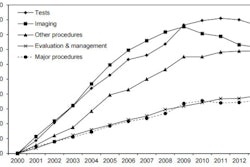
In perhaps a case of "no news is good news," the Medicare Payment Advisory Commission's (MedPAC) June 2014 report to Congress raises questions about how to revise Medicare payment policies, but it does not contain any new recommendations for imaging.
Medicare currently finances care through a traditional fee-for-service (FFS) structure, Medicare Advantage (MA) health plans, and, more recently, accountable care organizations (ACOs), which are a variation of FFS. Each model brings different and sometimes conflicting payment, risk adjustment, and quality measurement policies, MedPAC said.
"This report represents the beginning of a dialogue within MedPAC about how Medicare's policies across FFS, MA, and ACOs might evolve and how these differing policies might affect beneficiaries, providers, and taxpayers," said Glenn Hackbarth, chairman of the commission, in a statement.
Among other topics, the report addresses the following:
- Synchronizing Medicare policy across payment models
- Improving risk adjustment in the Medicare program
- Re-evaluating current approaches to measuring the quality of care in Medicare, with a discussion of an alternative approach
- Aligning financial assistance policies for low-income beneficiaries
- Paying for primary care using a per-beneficiary payment
The report discusses the need to measure inappropriate use of services, using imaging as one example of services that need to be monitored. MedPAC acknowledged that it can be difficult to define "clinically meaningful" quality measures for some specialties -- including radiology -- but said that it will continue its research.
"The commission ... plans to continue to explore overuse measurement as another way to improve quality, because of the potential for harm to beneficiaries and wasteful program spending that result from overuse," the report states.
MedPAC's report also discusses its concern that primary care services are undervalued by the Medicare fee schedule, and it uses radiology as an example of a specialty in which doctors earn twice as much as primary care providers: For example, radiologists' average annual compensation in 2010 was $460,000, while the average for primary care physicians was $207,000, according to MedPAC.
"Such disparities in compensation could deter medical students from choosing primary care practice, deter current practitioners from remaining in primary care practice, and leave primary care services at risk of being underprovided," the commission wrote.




















